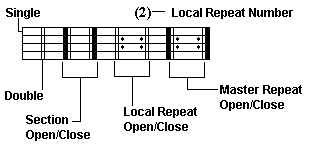Section 2: Score Elements
When looking at a score, there are several elements that define the entire work. We have reviewed some of them already, but for the sake of completeness we will define them again, and include a few new terms and definitions, whose full explanation and application will be covered in the section, Working Examples.

(Bar Lines)
- Bar line: Lines drawn vertically across the staff to divide it into measures and sections. Some of these "decorated" bar lines include:
- The double bar line.
- The local and master repeat bar lines, (open & close).
- Section open and close bar lines.
- Clef: A symbol indicating the pitch represented by one line of a staff, in relation to which the other pitches of the staff can be determined.
- Dynamic: The loudness or softness of a composition. Example are:
- piano (p) is used to indicate softness
- forte (f) to indicate loudness
- pianissimo (pp) - very soft
- pianississimo (ppp) - very, very soft
- fortissimo (ff) - very loud
- fortississimo (fff) - very, very, loud
- mezzo forte (mf) - somewhat loud
- Dynamic Variance: The gradual or sudden change in the loudness or softness of a composition, usually place before or after a dynamic mark. Examples are:
- Crescendo - to slowly grow louder; Appears as an elongated "greater than" sign.
- Decrescendo - to slowly grow softer; Appears as an elongated "less than" sign.
- Sforzando - sudden loudness
- Flow Direction: Mark or symbol notating a jump or shift to another part of a composition, (e.g. a repeat or special ending).
- Coda - The closing few measures of a composition, usually not a part of the main theme groups of the standard form of a composition, but a finishing theme added to the end to give the composition closure
- Segno - A sign in a composition that indicates a repeat
- Al Segno means to return to the sign and perform that section of the composition again.
- Dal Segno means to repeat from the sign. This directive is abbreviated: D.S.
- Da capo - A directive to the performer to go back to the beginning of the composition. This directive is abbreviated: D.C.
- Fine - An indication of where a composition ends when there is a repeat of some section of the composition in such a way as to make locating the ending confusing.
- D.C.al Fine - When you see the D.C.al Fine, you go back to the beginning and stop when you come to the Fine.
- Key Signature: The sharp, flat, or natural signs placed at the beginning of a staff indicating the tonality of the composition.
- Performance Style: Characteristic manner of presentation of musical elements (melody, rhythm, harmony, dynamics, form, etc.).
- Staff: A set of horizontal lines and intermediate spaces used in notation to represent a sequence of pitches, in modern notation normally consisting of five lines and four spaces.
- Tempo: The speed of the rhythm of a composition and is measured according to beats per minute. It is usually place above the staff, with the symbol of a quarter note followed by and equal sign and the value.
- Tempo Variance: Marks used to signal a change in the tempo of a composition, (e.g. breath mark or fermata).
- Accelerando - Gradually accelerating or getting faster. Abbreviated by accel.
- Allargando - Growing broader, louder and slower. Abbreviated by allarg.
- Ritardando - Gradual "delay" in tempo of a passage. The abbreviation is rit.
- Breath Mark - resembling a large comma or apostrophe, it is a directive to break the phrase at that point in the composition and breathe. It is always be located at the end of the phrase above the staff.
- Fermata - A notation marking directing the performer or ensemble to sustain the note of a composition affecting all parts and lasting as long as the artistic interpretation of the conductor allows. The fermata is marked above the note or rest to be held.
- Time Signature: A sign placed on a staff to indicate the meter, commonly a numerical fraction of which the numerator is the number of beats per measure and the denominator represents the kind of note getting one beat.
- There is a new time signature that was not previously mentioned and was used in the diagram Staff and Note Properties. It is called "Alle Breve" or "Cut Time." Alle Breve is so named because it cuts in half, the 4/4-time and makes it 2/2.